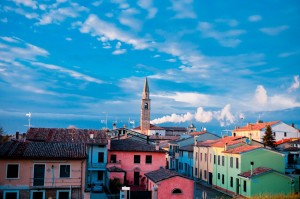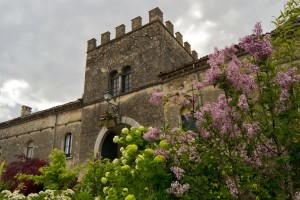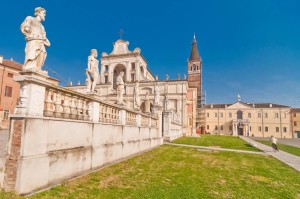
©Bigstock.com/eddygaleotti
One of the main topographical factors shaping the south of Lombardy is the Po Valley. In transition to plainer areas, bordering mainly on Emilia Romagna, numerous rivers create fertile soil and plenty of agricultural opportunities. Here you come across two provinces that – for Lombardy – are populated rather sparsely, yet still highly enough: Cremona and Mantua. A few bigger cities alternate with many smaller, friendly municipalities steeped in history and superb scenery. Eight of them – three in the Province of Cremona and five in the Province of Mantua – are part of the private association “I borghi più belli d’Italia” and absolutely need to be explored.
Province of Cremona
You probably mostly know the province in the Po Valley due to its capital. Cremona, a city of arts with great musical tradition, stands out just as much as the slightly smaller yet equally neat Crema. Furthermore, there are numerous hidden treasures in and around the many rivers and on the almost flat land. We take a look at the three most beautiful places in the Province of Cremona.
Castelponzone
Only 370 people live in Castelponzone, a frazione (quarter) of Scandolara Ravara. Merely the outlines remain of the old fortress La Rocca that used to dominate the village and provided refuge to its rulers. Even the fortifications have been broken down to just a few old walls. Beyond various churches, such as the 12th century Chiesa Vecchia and the newer parish church of Saints Faustino and Giovita, you head for a stately 18th century building simply known as “La Villa” – a plain yet fascinatingly decorated house with country-style undertones. The ropemaker museum introduces you to the old art of making ropes and cords.
Gradella
Gradella (approx. 270 inhabitants) is another frazione and actually part of Pandino. Even though the roots of one of the most beautiful places of Italy likely date back to the 8th century, its layout is much newer and was completely revamped after French looting in the early 18th century. Among the gems is the parish church Chiesa parrocchiale della Santissima Trinità e San Bassiano, rebuilt in 1895, the chapel outside the cemetery that was established in 1630 during the plague, and the enchanting, extensively altered Villa Maggi. Gradella itself is very much worth seeing as well. The fairly rural looking place is made up of numerous yellow-painted buildings with red brick profiles, seemingly from a different era.
Soncino
To this day Soncino (approx. 7,500 inhabitants) is surrounded by its old 15th century walls. The since extensively renovated fortress Rocca Sforzesca with its four towers was built during the same time. Even older, however, is the parish church Santa Maria Assunta. The brick building with its magnificent organ and stunning paintings can be traced back to the year 1150. The tower of the church San Giacomo, connected to a former Dominican convent, is leaning. The Soncino family, synonymous with high-quality print products, used to work in the Casa degli Stampatori where the first fully Hebrew bible with vocalised text was printed in 1488.
Province of Mantua
Did you know that there’s a UNESCO World Heritage Site in the Province of Mantua? The historic centres of Mantua and Sabbioneta, the latter we’ll tell you more about in a bit, received this distinction for their Renaissance beauty, showcasing the town planning in the 14th to 17th century, in 2008. The most beautiful places in the Province of Mantua have a lot of things worth seeing for you as well.

©Bigstock.com/giodilo
Castellaro Lagusello
Staying with World Heritage for a bit, there’s part of another UNESCO site in Castellaro Lagusello (approx. 450 inhabitants), a frazione of Monzambano. The pile dwellings Fondo Tacoli in the nature reserve Complesso morenico di Castellaro Lagusello were declared World Heritage Site in 2011 as one of 19 pre-historic pile dwellings. Enjoy a wonderful view of the heart-shaped lake in the reserve from the village founded during the 11th and 12th century. The old 13th century castle with four towers used to protect the place against repeat Gonzaga attacks. Another impressive sight is the stately Villa Arrighi with its superb façade and equally astonishing view. Don’t sleep on the rustic, timeless houses in the village centre with the baroque church San Nicola amidst them.
Grazie
Thank you very much: Grazie (approx. 530 inhabitants), a quarter of Curtatone, is mostly known for the sanctum Santuario della Beata Vergine delle Grazie. The Lombard-Gothic style building constructed at an elevated location in the early 15th century likely goes back to a small altar with an effigy of the Virgin Mary that was venerated by the rural population as early as the year 1200. Find 53 life-sized statues in the alcoves of the sanctum. The monumental, richly decorated interior alone is worth the visit. Fittingly, the annual international contest Madonnari on August 15th (Assumption Day) sees religious depictions painted onto the pavement with the most beautiful ones later conserved in a special museum.
Pomponesco
Town planning innovations by Giulio Cesare Gonzaga in the late 16th century led to the unique Latin cross layout of Pomponesco (approx. 1,700 inhabitants) with its narrow alleys and square channels. Even though other Gonzaga structures disappeared, such as the demolished castle (only the stables survived), the Piazza XXIII Aprile has pretty much stayed the same since the 17th century reflecting the former glory of this place. Numerous arcade-lined buildings, such as the town hall and the Chiesa arcipretale di Santa Felicita e dei Sette Fratelli Martiri, enclose the square. The old Palazzo Cantoni and the characteristic village theatre Teatro Comunale (inaugurated in 1900) are more than worth seeing.
Sabbioneta
The aforementioned World Heritage town is also known as the “little Athens” of the Gonzaga family. The noble clan who drastically changed Mantua from the 14th century onward inherited the castle of Sabbioneta (approx. 4,000 inhabitants) during the 16th century and turned the historic centre into an ideal town by greatly expanding it between 1554 and 1571. You can still experience the splendour of the first autonomously founded town of the Renaissance upon entering the place via the gates Porta Vittoria and Porta Imperiale. The ducal palace Palazzo Ducale, the magnificent antiques collection in the Galleria degli Antichi, the free-standing Teatro Olimpico with its Corinthian pillars, and the countless frescoes inside the private ducal villa Palazzo del Giardino are all must-see.

©Bigstock.com/eddygaleotti
San Benedetto Po
Tedald of Canossa founded a Benedictine monastery on an island originally surrounded by the river Po that has since ceased to exist after one tributary was drained. San Benedetto in Polirone might’ve lost its status as a monastery during Napoleonic reign in 1797, but you can still visit many a magnificent building today, such as the refectory, the newer infirmary, the church and three monasteries. This alone understandably makes San Benedetto Po (approx. 6,700 inhabitants) one of the most beautiful places of Italy, its countless parish churches, oratories, abbey villas, dairies and farms seemingly belonging to a different era in the best way possible.
World Heritage Sites, agricultural facilities, unique monasteries and sanctums, and idyllic small town centres accompany your tour of the most beautiful places in the Province of Cremona and the most beautiful places in the Province of Mantua. These small yet definitely beautiful gems form a stark contrast to the urban centres and invite you to daydream and dwell a little bit longer. Enjoy your trip to the multifaceted Northern Italian Po Valley!